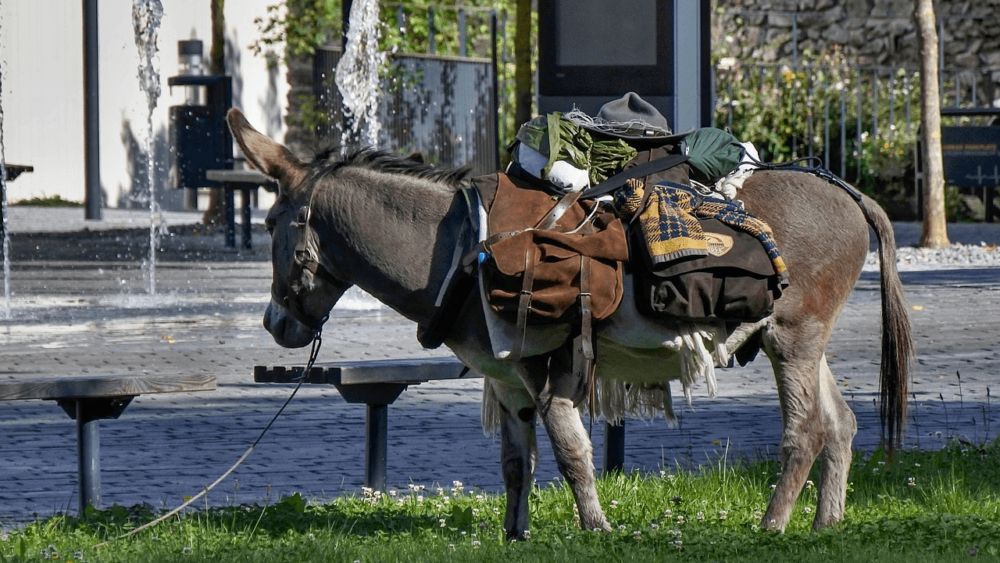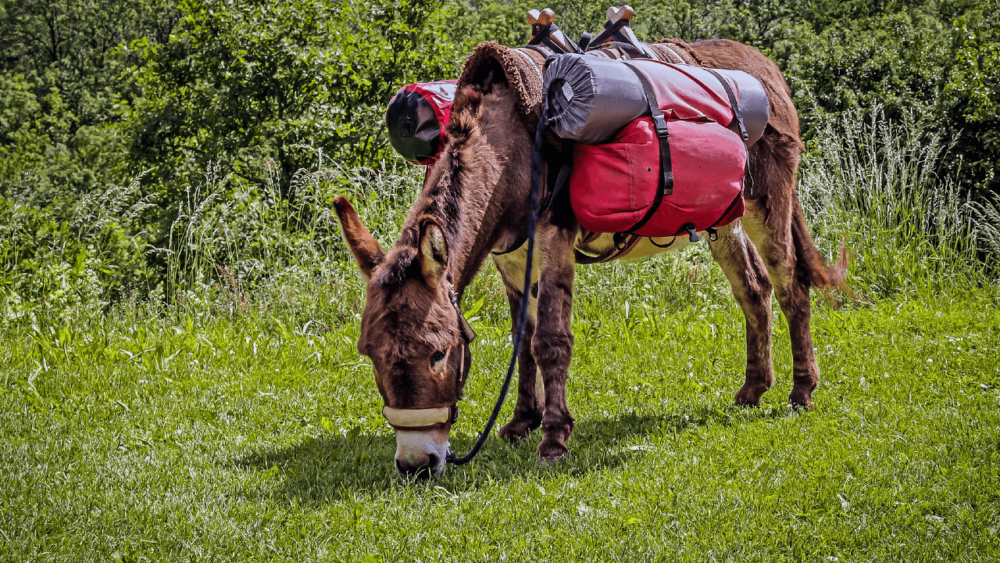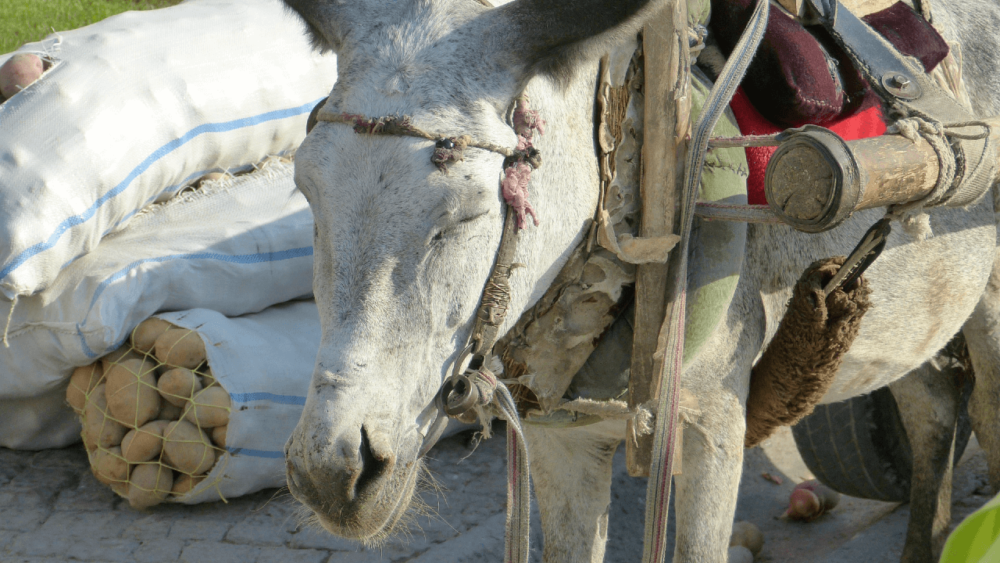I remember riding a donkey as a child, and it was perhaps one of the most jarring experiences of my life. Donkeys weren’t exactly built for comfort, but they can really carry a load. This is exactly what makes donkeys great pack animals.
With their sturdy little legs, they easily carry massive loads on the trail, and they don’t tire nearly as easily as a horse does.
But how do you get a trail donkey trail trained?
Trail training a donkey varies from training a horse, and you need a LOT of patience. Donkeys process information differently from horses, and they are less reactive than horses.
To trail train a donkey, first create a sense of exploration with new things. Add a small amount of weight, increase it slowly. Make sure the pack saddle fits comfortably. Lastly, increase your donkey’s fitness before attempting a long hike. Releasing pressure when your donkey response is essential to building a great partnership and rewarding any correct action timeously will help train your hike-buddy.
This is great news on the trail as your donkey is less likely to run off and get spooked, but it also means you need to take your time when you train them. Building trust, explaining new things on donkey-time, and rewarding often is what will create a great trail partner in your donkey.
Understanding Donkey Training Methods
When I trained my first trail donkey, it was a real eye-opener. Since I had been working with horses long before that, I expected the donkey to react the same way a horse does, and I was sorely mistaken!
Donkeys are truly lateral thinkers. A horse will respond and move off applied pressure. But, a donkey will resort to passive resistance (donkey stubbornness) while it thinks things over. As small as a donkey can be, they aren’t pushovers, and it’s almost impossible to move a donkey that doesn’t want to move.
I quickly learned that with a donkey, you want to use patience and explain things really slowly to them. Don’t get me wrong! It’s not that a donkey is stupid—in fact, they’re very intelligent. It’s just that you need to convince a donkey to partner with you, but once you do, they make amazing trail and training partners.
These are my donkey trail training methods, and I’m sure you will find them a lifesaver when you start training your own donkey for the trails.
Donkey Trail Training Methods
1. Approach Everything Slowly
When you halter your donkey, lead them, and work with them, you need to take it really slowly. Don’t try to rush or bully your donkey, or you will be taking many steps backward and none forward.
2. Release Often
From my experience in working with horses, I quickly learned to release pressure as soon as my horse did what I asked. It’s with the release of pressure that they learn. With a donkey, this is even more important.
As soon as your donkey steps forward at a gentle tug on the lead, you should release all pressure and give your donkey a lot of time to think about it. You may even want to drop the lead or let it drag on the ground for a few minutes, letting your donkey breathe and relax.
3. Ask Gently
Never ever try to make your donkey do something. While the expression is “as stubborn as a mule,” a donkey certainly excels at being resistant. Ask for every single step as gently as you can when your donkey starts their training. Reward frequently, praise often and ask even more gently next time.
4. Expose Your Donkey to New Things
A donkey has short legs and can’t run fast, so it has to really think whether something new is going to eat it or not. This means you need to help your donkey feel safe when it meets new things, which your donkey will often do out on a trail.
Take your time (and remember, you’re on donkey time) to really help your donkey relax and explore new things such as bags, chairs, raincoats, tarps, backpacks, hats, ropes, other animals, and people. A good way to start is to take your donkey out for walks in your area as often as you can. Let your donkey explore everything they meet.
By stimulating their curiosity, your donkey will develop a sense of adventure too. Soon, your donkey will look forward to seeing new places, things, and people.
5. Improve Your Donkey’s Fitness
When you go out on a trail, you will be going much further than normal with your donkey. They need to be fit if they are to keep up with you. If your donkey isn’t fit enough for what you ask of them on the trail, they will decide they don’t like going away with you. Then they will become resistant to trailing.
6. Train Your Donkey to Travel With a Pack Over Rough Terrain
While donkeys are strong, they need to develop muscle strength to carry a heavy pack on the trail. If you simply take them out of the pasture and make them carry a third of their body weight, they will not thank you for it. Next time, your donkey won’t want to go with you.
Instead, take the time to start with a lighter pack, securely fitted, to introduce your donkey to trailing with you. Perhaps it’s a walk around the homestead or a walk to the next-door neighbors with your donkey and a few random items in the pack. Build up the weight gradually until your donkey is able to carry all the items you need to pack for a trail and can confidently carry it. Then you know you and your donkey are ready for a trail ride.
7. Introduce Your Donkey to Friends for the Trail
Chances are that you will be going on the trail on horseback. While your donkey won’t be too bothered about the horses, you need to make sure the horses know and accept the donkey. This includes teaching your donkey not to tailgate the horses or kick at them if the horses start trotting.
Trail donkeys are usually quite content to follow you without a lead. In difficult or populated areas, they may need to accept being led from above. Be sure to teach your donkey to “pony” or lead from horseback. This is essential in areas where it is law to have a horse or donkey on a lead at all times.
So How Much Can Your Donkey Carry in a Trail Pack?
Your trail donkey will typically weigh in at 500 pounds and stand to about 14 hands. Smaller donkeys can also make a trek with you, as long as you keep in mind their gate is smaller and their legs are shorter.
For smaller donkeys, really rough terrain where they need to climb over rocks can be challenging as they can’t really reach that far, though their nimbleness will surprise you.
A trail donkey can safely carry as much as 125 pounds if the pack is correctly packed. Riding donkeys can carry more weight. And that’s the catch—an incorrectly packed donkey pack will unbalance the donkey, make them sore and tired, and they will soon not want to walk the trail with you.
How to Pack Your Donkey Pack
What you pack into your donkey’s pack influences how the pack will ride on the donkey. Be sure to pack both sides of the pack equally in terms of weight and size. A donkey will struggle to navigate the trail if the pack is larger to one side than the other. This kind of unevenly packed pack will hook on the passing brush and trees.
What to Pack for Your Donkey’s Needs
Your pack will contain items for your hike or trek, and if you are riding horses, you may want to include feed for the horses too. But what about the donkey? Should you pack food for them too?
If your donkey is used to receiving a concentrated ration, then be sure to pack them. A neat trick is packing rations for your horses and donkey in Ziploc bags. A few medium plastic bowls help you feed your horses and donkey without fear that they will eat dirt if you feed them straight on the ground.
Be sure to feed your equines only what they are used to eating. Don’t increase their feed on the day of the trail ride. Donkeys aren’t as tolerant to sugary feeds. Stick to roughage, a low protein but high fiber feed, and a few treats to encourage and reward your donkey.
Plan your trail so you can pass natural waterways or streams where your horses and the donkey can drink. If there is no water available, then you need to take water with for your equids to drink to avoid dehydration. Be sure to take water in bottles. If the weather is very hot, freeze the water the night before.
How Often to Water Your Pack Donkey
Your pack donkey will require about five gallons of water a day. Spread this into five or more watering sessions to avoid the water simply being peed out. Refill your water bottles at the available water sources to keep enough water on hand.
All About Donkey Poop on the Trail
On the trail, your donkey will have bowel movements. It’s inevitable that they will stop and leave a nice pile of droppings on the trail, so what now? Do you scoop it and take it with you, or can you leave it?
There are surprisingly not many laws about what to do with donkey and horse manure on trails in the U.S. Some parks have regulations and will probably inform you of which areas are “leave-the-poop” areas and which are “take-the-poop” areas.
Poop Courtesies on the Trail
On the trail, here’s what you do with your donkey’s poop:
- If the path is solid concrete, take the poop with you
- If the path is sand and level and used by other trail runners and hikers, take the poop with you
- If the path is natural, winding, and in hilly areas, leave the poop (it composts naturally)
- If the path is immediately next to a road, take the poop with you
And when you are transporting your horses and donkeys to the area you will have your trail ride, then the following poop etiquette applies:
- In a sandy parking area where there is no poop bin: leave the poop
- In a paved or tarred parking area: take the poop with you
Should your trail lead you through a nearby farmyard or town area:
- If it is a farm area where there is other animals’ poop lying around: leave the poop
- If the area is maintained and there is no poop: take the poop with you
You may choose to bury your equine poop on the trail, but this is not always the best practice. Rather take it with you and discard it at home. For the most part, your horse and donkey poop is not a threat to natural environments, and it only causes a fuss if they poop on a paved area where the poop won’t compost.
If you take your dog with you, this is an entirely different matter as dog poop doesn’t compost as horse and donkey poop does. This can create problems as you are required by law to pick up your dog’s droppings and take them with you.
Donkey Geldings, Stallions, or Mares for the Trail: Which Is Best?
When deciding on a donkey for a trail buddy, you have three options: a stallion (jack), gelding, or mare (jenny). Donkey stallions are notoriously difficult in temperament, and there is always the risk they could run into a donkey mare or a horse mare on the trail and heed nature’s call to mate, resulting in drama. Far better to use a donkey gelding or mare. With a jenny donkey, the risk of running across a stallion on the trail is also present, though she will be easier to handle than a jack donkey.
In the end, it depends more on the donkey’s individual temperament than their specific gender when it comes to the best trail donkey. After all, you want a willing partner with a bit of character, and that is not gender-related.
Ready for Your Next Trail Donkey
When you are ready to buy a trail donkey, you want to look for a donkey that checks these boxes:
- Willingly leads next to you
- Quietly follows and is not scared of things around them
- A soft eye
- Not a youngster, but not arthritic either
- No pack sores or boney spine that sticks up
- Straight legs
- Good hooves
- Between 13.3 and 14.2 hands in height
Final Preparations for the Trail
Before you begin training your donkey for the trail, be sure to have a qualified tack fitter come check the donkey pack on your donkey. An ill-fitting pack will cause your donkey to develop back soreness and even saddle sores.
Trail donkeys are fitted with a special trail pack-saddle, which can carry different types of saddle packs and saddle rolls. Don’t skimp on this as it’s no fun to have your donkey go lame on the trail from an ill-fitting pack saddle.
Conclusion
Taking a trail donkey with you when you hit the wilds is a great way to explore further, enjoy nature, and make new friends. Whether you are hiking or riding, you can take your trail donkey with you, teach them to walk at liberty, and train them to carry all the supplies and equipment you may need for your trail adventure.
My Favorite Equine Resources For Horses and Donkeys
This list contains affiliate products. Affiliate products do not cost more but helps to support BestFarmAnimals and our goal to provide farm animal owners with accurate and helpful information.
Squeaky Chicken Toy is hilarious to watch and the horses love it! It’s not super tough so keep it away from dogs.
Dewormer with Ivermectin: I use this for my horses and my goats. Duvet makes a great dewormer. I switch between the Ivermectin one and one like this one so the worms don’t get immune to it.
Manna Pro Apple Flavored Nuggets are a delicious smelling treat that my horses go crazy over.
Equinity Amino Acid Supplement for Horses makes a big difference for any horse that’s struggling with arthritis, hoof issues, or just generally. It’s great for older horses who can’t absorb all the nutrients in their food as well!
Manna Pro Weight Accelerator helps older horses gain weight and stay healthier! This was especially helpful when one of my older horses lost weight over the winter and helped her regain her weight over the summer!
Farnam Fly Control goes on the horse or donkey and will keep the flies off your sweet pet. It makes horses way more comfortable and will keep sores from getting infected as well.
Wound Kote protects sores and wounds. It acts as an antiseptic and helps wounds heal faster. It works on both my horses and goats.




